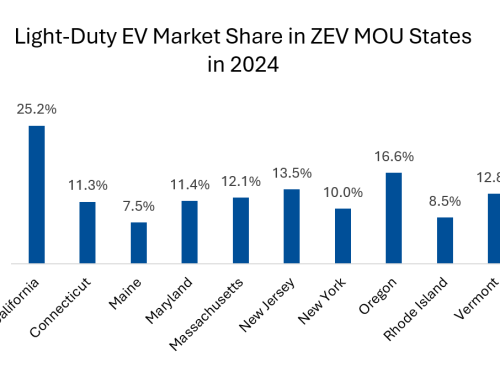
Image Source: Shutterstock
The following digest was written by Atlas Policy Analyst, Daniel Wilkins
Earlier this month, BloombergNEF published its annual Electric Vehicle Outlook (EVO), which aims to provide an in-depth analysis of the future of electric vehicles (EVs), shared mobility, autonomous driving, and other transformative trends in road transport. This comprehensive report draws on insights from a global team of specialists and explores scenarios affecting the automotive, oil, electricity, infrastructure, and battery materials markets, as well as CO2 emissions.
Broadly, BloombergNEF’s analysis finds that EV markets around the globe are growing, while some markets outpace others. While EV sales remain on an upward trajectory in some markets, the pace of growth is slowing down in some regions, including the United States. Further, the report argues that certain policy and industry measures, including tariffs and automaker setbacks, can slow down global EV adoption in the near term. Despite the overall progress, urgent policy action is required to address heavy commercial vehicles, streamline charging infrastructure, and build out the battery supply chain.
Below are three key takeaways from the report.
Global EV Growth: A Mixed Picture
The latest data reveals a mixed picture of global EV growth. While countries like China, India, and France are seeing robust increases in EV adoption, the United States, Germany, and Italy are experiencing growth at a slower pace. In contrast, less-developed markets such as India and China experienced significant YOY growth rates of 39 percent and 37 percent, respectively.
Despite the market’s current fluctuations, the long-term growth outlook for EVs remains positive. According to BloombergNEF’s “Economic Transition Scenario,” which forecasts EV growth based on current techno-economic trends, EVs are slated to reach 45 percent of global passenger-vehicle sales by 2030 and 73 percent by 2040. While global passenger EV sales are expected to grow in the near-term, the growth rate is predicted to be slower than before, underscoring the need for critical policy support to boost adoption rates in lagging markets.
Battery Technology Improvements
Stable battery technology is crucial for EV growth. The report highlights that the market share of lithium-iron-phosphate (LFP) batteries is on the rise, especially in China, where many manufacturers are based. LFP batteries have several advantages over other battery chemistries, including lower production cost. LFP batteries also do not require the production of cobalt, where concerns about cost and ethics persist. Within the next two years, LFP batteries are expected to account for 50 percent of the global passenger EV market, while critical minerals such as nickel and manganese are expected to dwindle. Advancements in LFP battery technology are also taking place, including improvements in their ability to charge in cold weather and increases in their energy densities.
The Rise of Plug-in Hybrids: A Temporary Trend?
One notable trend highlighted in the report is the rise of plug-in hybrid electric vehicles (PHEVs). Driven largely by affordable models from Chinese automakers like BYD and Li Auto, PHEV sales are increasing globally. In 2023, the average electric range of PHEVs hit 80 kilometers (km), with some models in China pushing well above 100km. PHEV battery pack sizes in China are almost twice the size of those deployed in the US and Europe, indicating a significant technological advancement. However, it remains uncertain whether this surge will be sustained long-term or if it is merely a short-term blip.
Upcoming EV Hub Live Podcast Episode
This Thursday at 3:30pm EST, our own Nick Nigro will sit down with Corey Cantor from BloombergNEF to delve into the findings of the 2024 Electric Vehicle Outlook on the upcoming episode of Atlas EV Hub Live. They will discuss the EV growth trends across the globe, recent automaker EV pullbacks, battery technology improvements, and more.
For the full report, visit BloombergNEF’s Electric Vehicle Outlook.

